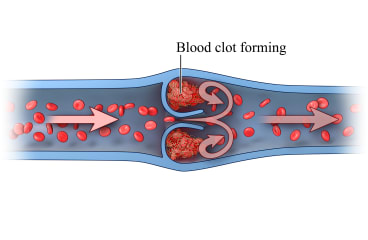What is a blood clot?

A blood clot is a clump of blood that forms in a blood vessel, such as a vein or an artery. If a clot gets stuck in a blood vessel, it can cause serious problems like a deep vein thrombosis (DVT) or a pulmonary embolism.
A DVT is a blood clot in certain veins of the legs, pelvis, or arms. It most often occurs in the legs. Blood clots in these veins need to be treated, because they can get bigger, break loose, and travel through the bloodstream to the heart and then to the lungs. This causes a pulmonary embolism.
A pulmonary embolism is a sudden blockage of an artery in the lung. Blood clots in the deep veins of the leg are the most common cause of a pulmonary embolism. In many cases, the clots are small. They may damage the lung. But if the clot is large and stops blood flow to the lung, it can be life-threatening.
What increases your risk for blood clots?
Some of the things that can increase your risk for a blood clot include:
Slowed blood flow
When blood doesn't flow normally, clots are more likely to develop. Reduced blood flow may result from long-term bed rest, such as after a surgery, injury, or serious illness. Or it may result from sitting for a long time, especially when traveling long distances.
Abnormal clotting
Some people have blood that clots too easily or too quickly. Things that may cause increased clotting include:
- Having certain blood problems that make blood clot too easily. This is a problem that may run in families.
- Having certain health problems, such as cancer, heart failure, stroke, or severe infection.
- Being pregnant. The risk of getting blood clots increases both during pregnancy and shortly after delivery or after a cesarean section.
- Using hormonal forms of birth control, gender-affirming hormone therapy, or hormone therapy for menopause.
- Smoking.
Injury to the blood vessel wall
Blood is more likely to clot in veins and arteries shortly after they are injured. Injury can be caused by a recent medical procedure or surgery that involved your legs, hips, belly, or brain. Or it can be caused by an injury, such as a broken hip.
What can you do to prevent blood clots?
After any procedure or event that increases your risk
- Take a blood-thinning medicine (called an anticoagulant) as directed if your doctor prescribes one.
- Exercise your lower leg muscles to help keep the blood moving through your legs. Point your toes up toward your head so the calves of your legs are stretched, then relax. Repeat. This is a good exercise to do when you are sitting for long periods of time.
- Get up out of bed as soon as you safely can or as soon as your doctor says it's okay after an illness or surgery. If you can't get out of bed, you can do the leg exercise described above. Try to do this leg exercise every hour when you are awake. This will help keep the blood moving through your legs. If you are in the hospital and need to stay in bed, your doctor may have you use a special device that inflates and deflates knee-high boots to help keep blood from pooling in your legs.
- Use compression stockings if your doctor prescribes them. These are specially fitted stockings that may prevent blood clots by keeping blood from pooling in your legs.
When you travel
- Take breaks when you travel. On long car trips, stop the car and walk around every hour or so. On long bus or train rides or plane flights, get out of your seat and walk up and down the aisle every hour or so.
- Do leg exercises while you are seated. For example, pump your feet up and down by pulling your toes up toward your knees and then pointing them down.
If you already have a risk of blood clots, talk to your doctor before taking a long trip. Your doctor may want you to wear compression stockings or take blood-thinning medicine.
Take care of your body
- Be active. Try to get 30 minutes or more of activity on most days of the week.
- Don't smoke. Smoking can increase your risk of blood clots. If you need help quitting, talk to your doctor about stop-smoking programs and medicines.
- Check with your doctor about your risk for blood clots if you use hormonal forms of birth control or any type of hormone therapy. These may increase your risk of blood clots.
When should you call for help?
Call 911 anytime you think you may need emergency care. For example, call if:
- You have symptoms of a blood clot in your lung (called a pulmonary embolism). These may include:
- Sudden chest pain.
- Trouble breathing.
- Coughing up blood.
Call your doctor now or seek immediate medical care if:
- You have symptoms of a blood clot in your arm or leg (called a deep vein thrombosis). These may include:
- Pain in the arm, calf, back of the knee, thigh, or groin.
- Redness and swelling in the arm, leg, or groin.
Where can you learn more?
Go to http://www.healthwise.net/patientEd
Enter F229 in the search box to learn more about "Learning About How to Prevent Blood Clots".
Current as of: October 2, 2025
Author: Ignite Healthwise, LLC Staff
Clinical Review Board
All Ignite Healthwise, LLC education is reviewed by a team that includes physicians, nurses, advanced practitioners, registered dieticians, and other healthcare professionals.

